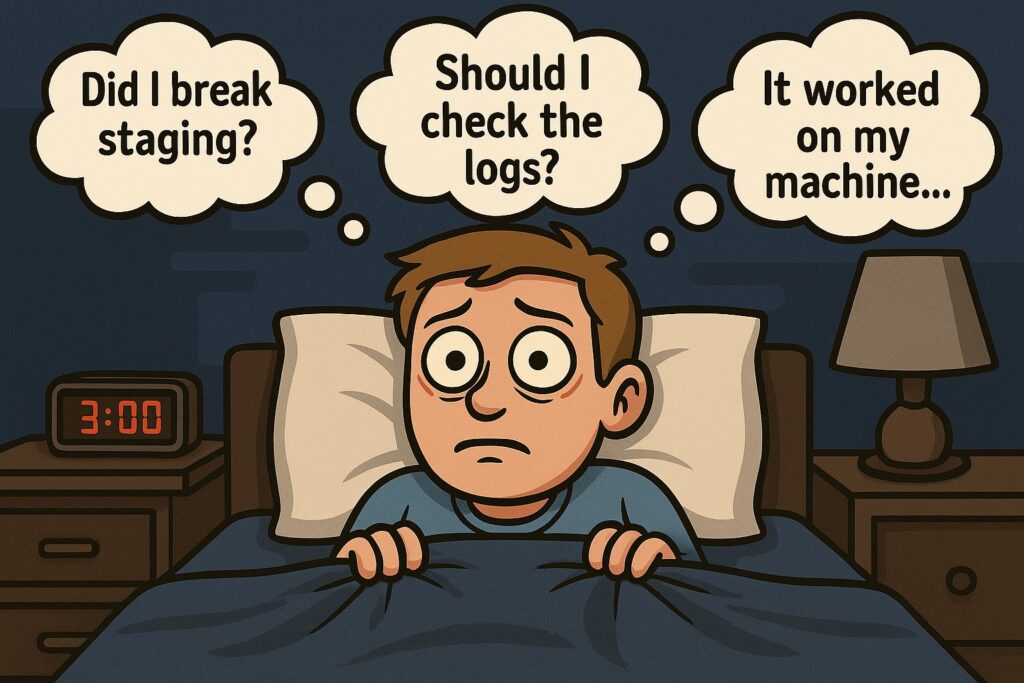The fastest feedback loop you’re not using enough.

Most of us like to believe we write good code—maybe even great code. We test as we build. We poke around in Postman. We check the happy path. We tell ourselves: “Yeah, this is solid.”
But then something happens. You push your beautiful, handcrafted update to production… and get a bug report. Not about your new feature—but something completely unrelated. Weird, right?
You didn’t touch that part of the system. But your change had a side effect. Or maybe it worked locally, but broke in staging because of a config mismatch. Or someone else’s service expected something slightly different. And now you’re chasing bugs for two hours, wondering what the hell happened.
This kind of thing used to stress me the hell out. I’d deploy something and feel the weight of it for hours. I’d check logs obsessively after work. I’d wake up at 3 a.m. wondering if I broke something I didn’t catch. It wasn’t sustainable—and it made me dread shipping.
That’s when it clicked for me: I didn’t need more confidence. I needed proof. And that’s exactly what test-driven development (TDD) gave me.
What Changed When I Started Writing Tests First
At first, writing tests felt slow. I’d define an interface or method and immediately switch over to write a unit test for it. Sometimes two. Sometimes ten. But over time, that “slow” approach turned out to be the fastest path forward—because I wasn’t doubling back to fix things later.
And more importantly, I was finally able to move fast without breaking shit.
My confidence as a developer skyrocketed. Not in the fake, “I’m sure it’s fine” way—but because I had fast, reliable feedback. If something broke, I knew about it instantly. If my test suite passed, I could move on.
Stacking Layers of Confidence
TDD really shines when you build it in layers. For example:
- A method that talks to the database? Has its own tests.
- A business logic method that uses that? Tested.
- A controller or API endpoint that uses that business logic? Also tested.
- And then a full integration test that hits the entire stack—from client to database and back.
With that setup, I didn’t need Postman. I didn’t need to manually test everything. I didn’t need to hold my breath before every deploy. I knew the system worked.
Sure, some edge cases still slip through. But for 95% of what matters, this changed everything.
My Stack (for the Curious)
I did most of this in .NET using:
- NUnit for unit testing
- Moq for mocking dependencies
- Bogus or AutoFixture for generating test data
It was simple, effective, and easy to onboard others into.
Bonus: A Tiny Tip That’ll Save You Hours
If you’re using C# or Java (or really anything), don’t “new up” dependencies inside your methods. That makes testing a nightmare. Instead, pass them in—either as method parameters or via interfaces. That way, everything’s mockable, swappable, and testable without duct tape.
(And yes, I’ll write a full post on that pattern soon.)
Takeaway
Test-Driven Development isn’t just about tests. It’s about freedom.
It’s about not being the person who hopes their code didn’t break something.
It’s about writing once—and knowing it works.
I’m not saying every single thing needs a test. But I am saying that the best thing I ever did for my sanity (and my career) was learning to test the hell out of my code!
Homework
Here is a helpful video if you haven’t gone down the TDD path in C# before.
💡Liked this post?
Get real-world solutions like this in your inbox—join the newsletter.